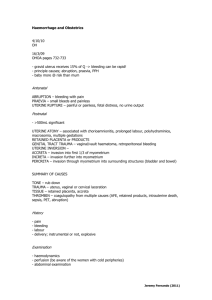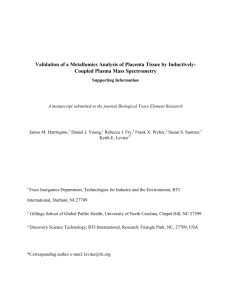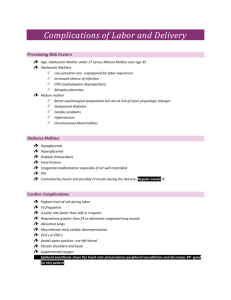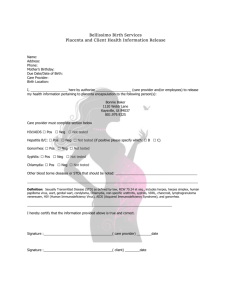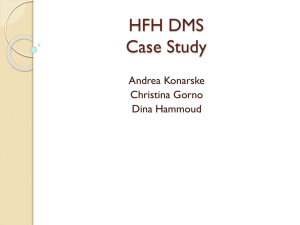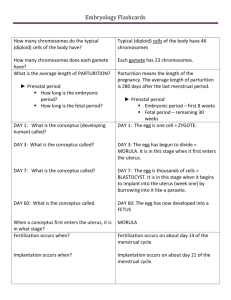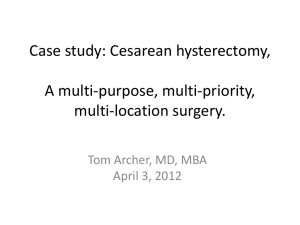Placenta Accreta Proof One - Scottish Universities Medical Journal
advertisement
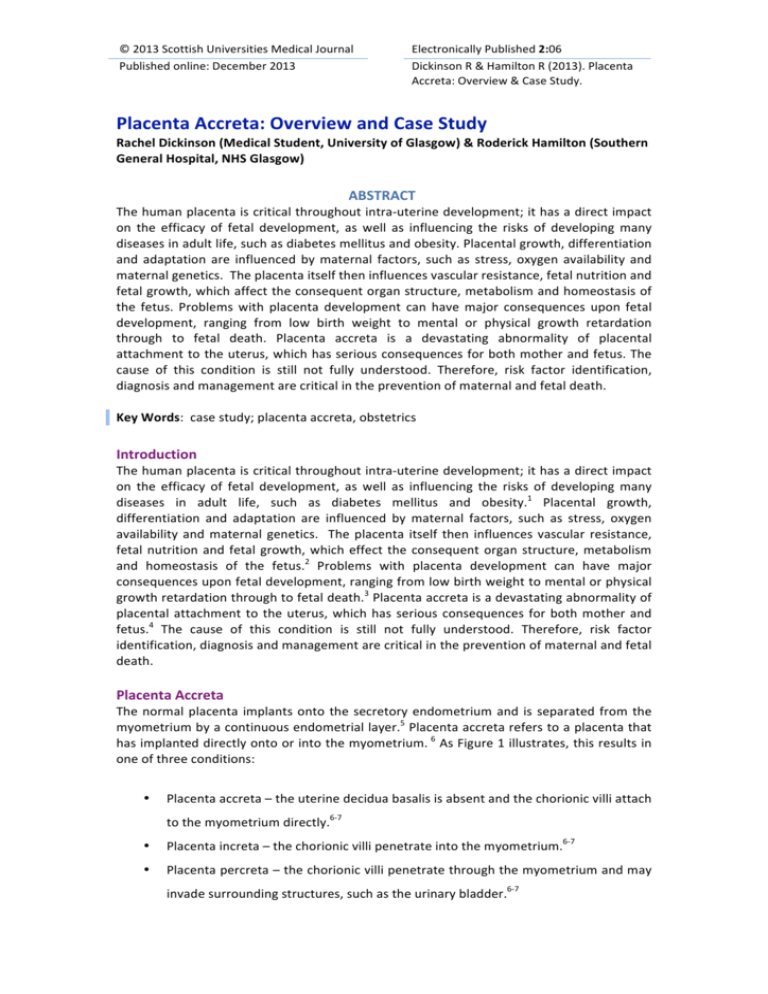
© 2013 Scottish Universities Medical Journal Published online: December 2013 Electronically Published 2:06 Dickinson R & Hamilton R (2013). Placenta Accreta: Overview & Case Study. Placenta Accreta: Overview and Case Study Rachel Dickinson (Medical Student, University of Glasgow) & Roderick Hamilton (Southern General Hospital, NHS Glasgow) ABSTRACT The human placenta is critical throughout intra‐uterine development; it has a direct impact on the efficacy of fetal development, as well as influencing the risks of developing many diseases in adult life, such as diabetes mellitus and obesity. Placental growth, differentiation and adaptation are influenced by maternal factors, such as stress, oxygen availability and maternal genetics. The placenta itself then influences vascular resistance, fetal nutrition and fetal growth, which affect the consequent organ structure, metabolism and homeostasis of the fetus. Problems with placenta development can have major consequences upon fetal development, ranging from low birth weight to mental or physical growth retardation through to fetal death. Placenta accreta is a devastating abnormality of placental attachment to the uterus, which has serious consequences for both mother and fetus. The cause of this condition is still not fully understood. Therefore, risk factor identification, diagnosis and management are critical in the prevention of maternal and fetal death. Key Words: case study; placenta accreta, obstetrics Introduction The human placenta is critical throughout intra‐uterine development; it has a direct impact on the efficacy of fetal development, as well as influencing the risks of developing many diseases in adult life, such as diabetes mellitus and obesity.1 Placental growth, differentiation and adaptation are influenced by maternal factors, such as stress, oxygen availability and maternal genetics. The placenta itself then influences vascular resistance, fetal nutrition and fetal growth, which effect the consequent organ structure, metabolism and homeostasis of the fetus.2 Problems with placenta development can have major consequences upon fetal development, ranging from low birth weight to mental or physical growth retardation through to fetal death.3 Placenta accreta is a devastating abnormality of placental attachment to the uterus, which has serious consequences for both mother and fetus.4 The cause of this condition is still not fully understood. Therefore, risk factor identification, diagnosis and management are critical in the prevention of maternal and fetal death. Placenta Accreta The normal placenta implants onto the secretory endometrium and is separated from the myometrium by a continuous endometrial layer.5 Placenta accreta refers to a placenta that has implanted directly onto or into the myometrium. 6 As Figure 1 illustrates, this results in one of three conditions: • Placenta accreta – the uterine decidua basalis is absent and the chorionic villi attach to the myometrium directly.6‐7 • Placenta increta – the chorionic villi penetrate into the myometrium.6‐7 • Placenta percreta – the chorionic villi penetrate through the myometrium and may invade surrounding structures, such as the urinary bladder.6‐7 According to Shnider, S et al, the incidence of placenta accreta is 1 in 2500 pregnancies.6 However, it is reported that this number is increasing and this rise is likely due to the increasing numbers of caesarean sections being performed.8 It is important to note that the majority of studies showing an increase in placenta accreta cases (and the number of caesarean sections) have been carried out in America, Europe, or other economically developed areas and so can only reflect the incidence within developed countries. Studies carried out in developing countries would likely show much lower incidence of placenta accreta, as they may not have the resources to carry out appropriate diagnostic techniques and may be unable to recognise placenta accreta until delivery. However, as more countries develop their healthcare systems, this problem is likely to increase worldwide Figure 1 – Classification of Placenta Accreta Source: authors' own diagram Placenta accreta is associated with major intra‐operative blood loss and in some cases maternal death.6‐7 It is reported that the average blood loss in a patient with placenta accreta is between 2000 and 5000ml and as a result patients often require blood transfusions.6 Although potentially lifesaving, blood transfusions carry their own risks and consequences, such as bacterial contamination of platelets and transfusion‐related acute lung injury.9 Between 30% and 72% of patients with placenta accreta require hysterectomy and due to the serosa invasion associated with placenta percreta further surgical complications may arise, such as cystectomy.6, 7, 10 In order to minimise the morbidity and mortality related to placenta accreta, it is important that those with the condition are identified before delivery; this allows the obstetric department to create a management plan that helps them to cope effectively with various outcomes.7 However, since the aetiology of this condition remains unknown, identification of potential placenta accreta patients involves risk factor recognition. Current evidence, highlighted in Table 1, suggests that the top three risk factors for placenta accreta are multiparity, previous placenta praevia and previous caesarean section.4 Table 1 – Risk Factors for Placenta Accreta Risk Factor Placenta Accreta Cases (% with the risk factor identified) 77% 63.6% 27% 27% 27% 9% Multiparity Previous placenta praevia Previous caesarean section History of dilatation and curettage History of miscarriage or abortion Previous postpartum haemorrhage with retained placenta Multiple pregnancy 9% Source: authors’ own table, adapted from Read, J., et al.4 In the UK, detailed pregnancy records should allow straightforward identification of multiparous women and of women with a history of any risk factor. However, the highest incidence of placenta accreta is seen in women with placenta praevia who have a history of a previous caesarean section.10 This risk increases as the number of caesarean sections increases, as illustrated in Table 210. Therefore, whilst records can be used to evaluate a woman’s past obstetric history for risk factors, placenta praevia must be understood and reliably diagnosed in order to further stratify women at high risk for placenta accreta. Table 2 – Risk of Placenta Accreta in Placenta Praevia Patients Increases with Number of Previous Caesarean Sections Previous Caesarean Sections Placenta Accreta Case (number) (% of patient with placenta praevia) 0 5% 1 24% 2 47% 3 40% 4 67% Source: authors’ own table – adapted from Clark, S. et al.10 The term ‘placenta praevia’ refers to a condition where the placenta develops and remains in the lower uterine segment.11 The sequelae of this depends upon whether the placenta praevia is ‘marginal’, where the placenta lies near but does not cover the cervix, ‘partial’, where the placenta covers part of the cervix, or in the worst case a ‘total’ placenta previa, where the entire cervical os is covered by placenta.8 Whilst the definitive cause of placenta praevia is unclear, the risk factors for this condition are similar to those for placenta accreta, including previous caesarean sections, multiparity and previous uterine surgery.6, 8, 10 Therefore, the risk of developing either placenta praevia and/or placenta accreta appears increased where there is a history of uterine trauma. This trauma may result in the development of scarring within the lower uterine segment. It is thought that a subsequent placenta implanting on this scarred tissue may then develop abnormally.8 It has also been suggested that ageing, resulting in progressive vascular endothelial damage, inappropriate decidual reaction in the lower uterine segment and a genetic predisposition also have a role in the development of placenta accreta.7 Placenta Accreta: A Case Study Mrs X, a 22‐year‐old multiparous woman, was diagnosed with a “placenta accreta and probably placenta percreta involving the right inferior lateral placenta” following a pelvic MRI. She had a history of three caesarean sections resulting in live births; her third pregnancy had been complicated by placenta praevia but otherwise there had been no obstetric issues. This pregnancy had been unremarkable and she denied any vaginal bleeding throughout. She was referred for the pelvic MRI following abnormal ultrasound scans at 20 weeks gestation (two abdominal and one transvaginal). In concordance with current guidance, she was admitted for an elective caesarean section at 36 weeks and 5 days gestation.12‐13 Preoperatively, Mrs X consented to the operation, as well as further intervention if required, including interventional radiology, hysterectomy, cystectomy, vascular dissection, colectomy and/or blood transfusion. Two senior anaesthetic consultants managed this case, which took place under a general anaesthetic (GA), and a consultant interventional radiologist preoperatively inserted bilateral femoral artery catheters; both precautionary measures due to Mrs X’s high risk of intraoperative haemorrhage. The caesarean section was carried out by a senior obstetric consultant via a vertical incision, as the high risk of haemorrhage meant a hysterectomy may be required. The baby was delivered without complication and immediately transferred to the neonatal intensive care unit. The uterus was then inspected and there appeared to be a “grade IV placenta praevia with morbid adherence”. The obstetrician then carried out manual evacuation of the placenta and further inspection of the uterus to ensure no placenta had been retained. Unfortunately, at this point Mrs X had a severe postpartum haemorrhage, therefore, the obstetrician performed a B lynch suture to compress the uterus. However, this failed to provide haemostasis and Mrs X became significantly hypotensive. The consultant anaesthetist inserted a central line to increase intravenous access and initiated a rapid blood transfusion. The interventional radiologist inflated both femoral artery balloons, in an attempt to reduce blood flow through the uterine arteries. This failed to significantly control the bleeding and the decision was made to perform a hysterectomy. This was completed without complication but, once again, did not provide haemostasis, and the obstetrician was struggling to determine the bleeding site. The femoral artery catheters were then used to carry out an angiogram, which allowed the interventional radiologist to finally achieve haemostasis via bilateral uterine artery embolisation. Mrs X lost approximately 3500mls of blood intraoperatively, which had a significant impact on her post‐operative recovery. Whilst her baby was clinically well in the paediatric unit following delivery, Mrs X was transferred to the high dependency unit for intense haemodynamic monitoring. During her recovery it was noticed that she had developed right‐sided weakness in her face and arm, which was thought to be the result of an ischaemic stroke that occurred intraoperatively. Consequently, Mrs X was transferred to the Institute of Neurology for focused post‐stroke rehabilitation. Discussion Women in the UK are currently offered two abdominal ultrasound scans during their pregnancy, one at 10‐13 weeks and the other at 18‐20 weeks.12 At both scans the position of the placenta is reported, which should act as a screening programme ensuring the majority of patients with possible placenta praevia are identified by the second scan. These patients are then offered another abdominal ultrasound at 32 weeks and if the diagnosis is still unclear they will be offered a transvaginal colour Doppler ultrasound, which offers increased diagnostic sensitivity compared to the abdominal ultrasound.8,12 If placenta accreta, increta or percreta is suspected, the location and level of infiltration of the placenta can be further assessed by MRI, as was carried out in the case of Mrs X.8 However, many cases of placenta accreta are not reliably diagnosed until the placenta is physically examined during caesarean section.6 This may be because some patients, such as Mrs X, do not experience any vaginal bleeding during pregnancy, the main symptom of both placenta praevia and accreta.6 Additionally, ultrasound may only successfully diagnose 45% of placenta accreta cases.7 There may be many reasons for this, including the sensitivity of the equipment, the sensitivity of the criteria for placenta accreta diagnosis or lack of ultrasonographer experience in recognising the condition. Where placenta accreta, increta or percreta is suspected, the obstetricians and anaesthetists must prepare for the possibility of massive haemorrhage, hysterectomy and other potential sequelae.6 Current guidance indicates that prior to delivery, all complications should be discussed with the patient and formal consent for any poteintal interventions obtained.13 Furthermore, the guidelines state that if a woman with confirmed placenta praevia has an episode of vaginal bleeding she should be managed as an inpatient from 34 weeks gestation onwards and that every unit must have a protocol for the management of massive haemorrhage in placenta praevia or accreta patients, which must include “liaison with haematology, giving warm blood rapidly, criteria for invasive monitoring and management of women who refuse blood products”.13 Additionally, it was advised following the 2005 ‘Confidential Enquiry into Maternal Deaths in the UK’, that all caesarean sections in women with placenta praevia or accreta, particularly those with previous caesarean section, be performed by the most experienced consultant obstetrician.13 Overall, Mrs X was at high risk of developing placenta accreta due to her past obstetric history, including three caesarean sections and one pregnancy with placenta praevia. The diagnosis and management of her delivery were in‐keeping with current recommendations.12‐13 However, whilst the guidelines state various ways of reducing morbidity and mortality through diagnosis and management, there is very little detail as to what protocols intra‐operatively can help further reduce complications. Mrs X’s postpartum haemorrhage began during the time‐consuming, manual removal of the placenta. According to Eller et al morbidity in patients with placenta accreta was reduced by scheduled caesarean hysterectomy with no placental removal attempted.14 Therefore, there is evidence to suggest that women with placenta accreta, who have completed their families, should be given the opportunity to opt for hysterectomy without any attempt to manually remove the placenta. However, the evidence for this change is limited and could only be recommended following further trials assessing maternal outcome. Conclusion Placenta accreta is a potentially life threatening condition for both mother and baby. The limited understanding of the nature of this condition means that those likely to develop it must be identified through risk factor analysis. Currently, prompt diagnosis of placenta accreta, followed by the development of a delivery management plan that include several haemorrhage‐control contingency options, is the only way to reduce the maternal morbidity and mortality associated with this condition. Therefore, this case highlights the need for further research into the prevention of abnormal placental development, so that treatment of complications is not the mainstay of management in this condition and to reduce the risk of massive haemorrhage or emergency hysterectomy in these women. This case also emphasises the importance of the multi‐disciplinary team, which included radiographers, theatre nurses and consultants, who all played a vital role in ensuring the survival of Mrs X and her baby. References 1. Kay, H., Nelson, M., and Wang, Y., (2011) The Placenta from Development to Disease. Oxford Wiley‐Blackwell, Oxford 2. Burton, G., Barker, D., Moffett, A., and Thornburg, K., (2011) The Placenta and Human Developmental Programming. Cambridge University Press, Cambridge 3. Gagnon, R., (2003) Placental Insufficiency and its consequences European Journal of Obstetrics & Gynecology. 110:S99‐S107. Available from: http://www.ejog.org/article/S0301‐2115(03)00179‐9/abstract 4. Read, J., Cotton, D., and Miller, F., (1981) Placenta Accreta: Changing Clinical Aspects and Outcome Obstetrics & Gynecology. 60:367‐368 5. Stocker, J., and Dehner, L., (2001) Pediatric Pathology Volume One Lippincott Williams & Wilkins, USA 6. Shnider, S., and Levinson, G., (1993) Anesthesia for Obstetrics 3rd Edition Williams & Wilkins, USA 7. Gielchinsky, Y., Rojansky, N., Fasouliotis, S., and Ezra, Y., (2002) Placenta Accreta – Summary of 10 Years: A Survey of 310 Cases Placenta. 23:210‐214 8. Chestnut, D., (1994) Obstetric Anesthesia Principles and Practice. Mosby, USA 9. Goodnough, L., (2003) Risks of blood transfusion. Critical Care Medicine. 31(12):S678‐S686. Available from: http://journals.lww.com/ccmjournal/Abstract/2003/12001/Risks_of_blood_transfus ion.6.aspx 10. Clark, S., Koonings, P., and Phelan, J., (1985) Placenta Previa/Accreta and Prior Cesarean Section. Obstetrics & Gynecology. 66:89‐92 11. Collier, J., Longmore, M., Turmezei, T., and Mafi, A., (2008) Oxford Handbook of Clinical Specialties. Eight Edition, Oxford University Press, Oxford 12. NHS NICE Guideline 62 Routine antenatal care for healthy pregnant women. (Updated March 2008, accessed 22/06/11). Available from:http://www.nice.org.uk/nicemedia/pdf/CG062PublicInfo.pdf 13. Royal College of Obstetricians and Gynaecologists Guideline No. 27 Placenta Praevia and Placenta Praevia Accreta: Diagnosis and Management (Updated 2005, accessed 22/06/11). Available from: http://www.clinicalguidelines.scot.nhs.uk/Labour%20Suite/RCOGGT27PlacentaPrevi aAccreta2005.pdf 14. Eller, A., Porter, T., and Silver, R., Optimal management strategies for placenta accreta BJOG; 2009, 116:648‐654
